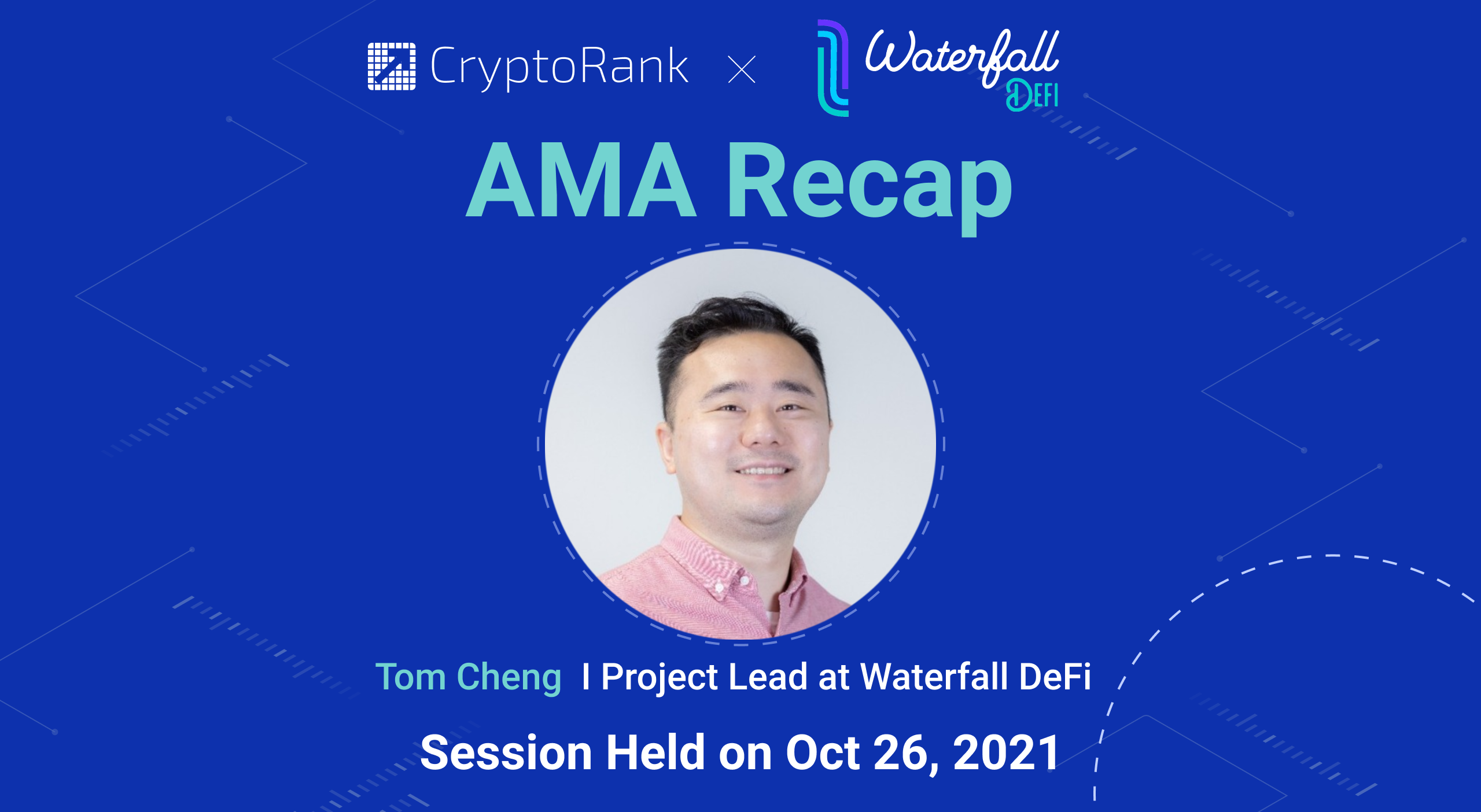Waterfall DeFi AMA Recap

Waterfall DeFi is a yield aggregator protocol that aims to bring true risk tranching to the DeFi landscape.
On October 26, Tom Cheng, Project Lead of Waterfall DeFi joined us to answer our questions.
 Tom Cheng, Project Lead of Waterfall DeFi
Tom Cheng, Project Lead of Waterfall DeFi
Before going full time in crypto I was working in management consulting, operations, and strategic planning. I started off my crypto journey back in 2017, my buddy was at MIT Lab and was using the lab to mine ETH, so I joined on his bandwagon, and have been on and off since then.
Questions from the CryptoRank team
#1. Can you tell us about Waterfall DeFi? What problems do you solve, both in the space and for the community?
Tom C.: – Waterfall DeFi is a yield aggregator protocol that aims to bring true risk tranching to the DeFi landscape. We are built on BSC initially and would develop portfolios that include different farms. Instead of just offering a yield aggregation product, we actually would slice the portfolio into different “tranches” – essentially each tranche represents a risk/reward combo that would allow the users to select. The senior tranche would receive a reduced yield return, in exchange for first lost protection. Junior tranche would receive a much higher, leveraged yield return, but their capital is used to cover any losses suffered from the portfolio.
For example – in a portfolio with a 10% expected yield, after we slice it into 2 tranches, the senior tranche will receive a 5% return, while the rest will flow to the junior tranche. So in a perfect world, the junior tranche will get 15%. The senior tranche is essentially using its future return to buy protection against any capital lost. So in this example – if the farm underperform and the return is only 3% – seniors will still get their 5% (as they are being paid out first), while junior might see a 2% loss in their capital.
The goal is to create different types of investment options and risk factors that users can select based on their preferences.
#2. Could you briefly describe the milestones Waterfall DeFi has achieved, and about your upcoming plans?
Tom C.: – The first milestone for us is to decide which blockchain to focus on, and we decided to go with BSC, due to its negligible gas fee and presence of high TVL farms with the sustainable return. Then the second milestone would be launching our first product – which would include 3 BUSD farms. Going forward, once we are more mature and the community is more educated about the product, we will be pushing out not just a safe, sustainable return package with major farms and high TVL, but also risky leveraged products and new farms with high APY.
We are now hard at work to get everything tested, which is currently underway. We are working with our auditor to review our smart contract, finalize our dApp’s interface and make sure everything is ready.
For the mainnet launch, it will depend on our testing process. Once we get the feedback from the community and adjust based on the suggestions, we will be ready.
Finally – one of the biggest achievements we have is the list of our tokens on AscendEx and Pancakeswap – really push us on the roadmap and we are excited to see the price we are trading at ~2x of our listing price. Need to make sure we get the product out ASAP to keep the momentum going.
Questions from Twitter
#1. Waterfall DeFi charges any commission for withdrawing and depositing funds on its platform, if so, where do the funds collected from said commissions collected go, that is, what use do they give to said funds raised, are they destined in their entirety for the continuous?
Tom C.: – Correct – we actually have a very small amount of % attached to each transaction. The fund collected will be put into two uses. Part of it will be used to provide the basic operation of the protocol, making sure that we can keep the project going and expanding. The rest we will actually be rewarding back to the community. Those who staked us on the protocol will receive a governance token veWTF. Those who hold veWTF tokens will get a share of the transaction fee pool – thus making sure that people holding our token will have the right return.
Going forward, the reward ratio will be determined by the DAO once it is set up – and the initial split will be shared with the community soon.
#2. What kind of partnerships with different projects/platforms/protocols can we expect from Waterfall DeFi in the future? Could you give us some examples of how other projects can leverage Waterfall DeFi?
Tom C.: – So yes – for the partnership we can envision those we are building on top of and those that will build on top of us. For example – those we are building on top of – that would include all different types of crypto platforms that have yield generating assets. For example, right now our first product will consist of 3 BUSD farms on BSC – Alpaca, Venus, and C.R.E.A.M. – those are strong, high TVL, yield farming platforms that fit perfectly with our partner profile. We are already talking to them and will have more announcements coming out once the product is out. Meanwhile – going forward we will be tranching more and more products, which would further expand our product range.
For projects that can build on top of us – that includes wealth management trackers, DeFi dashboards, or other tranche-related services (risk management profile) – which can be helpful to users who are not familiar with the landscape and want some good information.
#3. As Waterfall DeFi, why are you absent from Ethereum and Polygon networks? Do you have any plans to work on these networks in the coming days?
Tom C.: – In our opinion BSC is the second most mature defi space, with a lot of mature, high TVL farms right now, and the gas fees are negligible. That being said, this is just the first step, and we are actively looking at expanding into other blockchains in the near future. Expanding to Solana and other EVM-compatible chains is on the roadmap, EVM side is easier since most of the codebase can be reused, Solana we will expand our team with rust developers to do the work.
Questions from Telegram
#1. Is your project only for elite investors, what about others with small funds, is it open to everyone?
Tom C.: – Our product is open for all! We deliberately designed the protocol to be as simple as possible – to ease users into the process and make sure the resistance is low for anyone to join. Risk tranching is not a super straightforward concept, but it is not something like rocket science. Traditional finance likes to hide this behind fancy jargon and complicated numbers, but in fact, it is some basic math related to how users could hedge against each other. The team is passionate about this and would like to introduce the concept to our community, working with them to bring new ideas to this space, and innovate with the help of our community. With a gradual approach to launching our protocol, I invite all our community to embark on this journey with us.
#2. Do you have tutorial videos so we can get to know your project more clearly or do you have a YouTube channel or something? Can you share it with us?
Tom C.: – We have a youtube channel – and we now have a very simple, 5 mins, in-a-nutshell video that can share with the community. It’s supposed to clarify the background of the product to everyone: https://youtu.be/lAEPG6tcWjk
#3. Tell us a little bit about security? Have you done an audit of the platform? Are the smart contracts error-free? What are the test results?
Tom C.: – Yes, security is a key issue and we take it seriously. For our protocol, we can classify risk in two different segments:
- The risk that with our protocol’s code
- The risk that’s associated with the underlying pools that in our product portfolio (3rd party)
For the first one, we take measures and work with a renowned auditor (Slowmist) to review our codebase, they did the initial review and gave us some feedback (thank god it’s relatively minor) and we had updated the contract based on their suggestions. Auditors will soon review our code when it’s deployed on the mainnet and we can’t wait to share with the community to boost their confidence in us. Meanwhile, going forward we soon launch our bug bounty program and continue to work with different auditors and other developer friends we have to peer review the code, making sure that we are always vigilant about checking and reviewing the security
For the second one, We usually would evaluate the risk involved in different crypto assets based on a couple of factors, including the reputation of the team/protocol, amount of TVL committed by the community, the sustainability of the yield return, etc.
That’s why we introduce 3 BUSD stablecoin farms that all have high TVL and sustainable yield, which is the most secure/safe approach to engage with our first ever product launch. We will also limit the TVL for our first product to ensure we can plan for a smooth launch.



